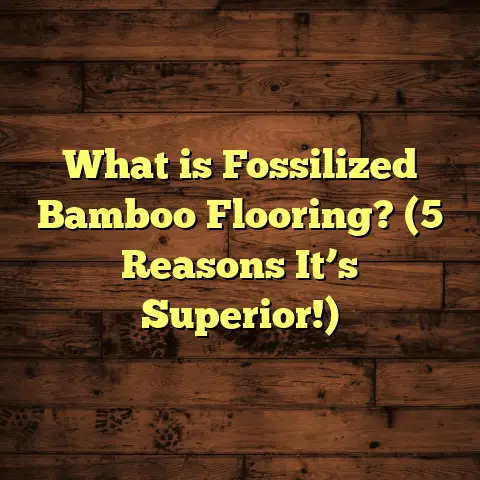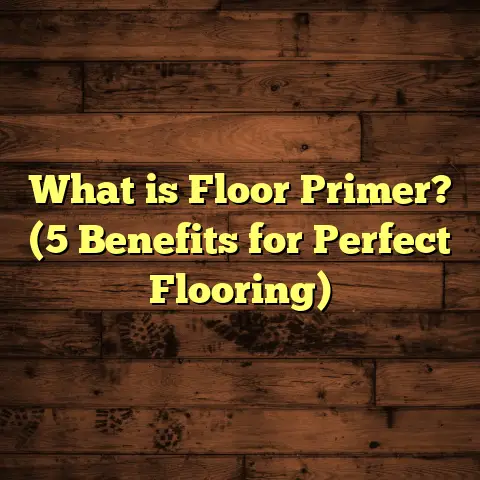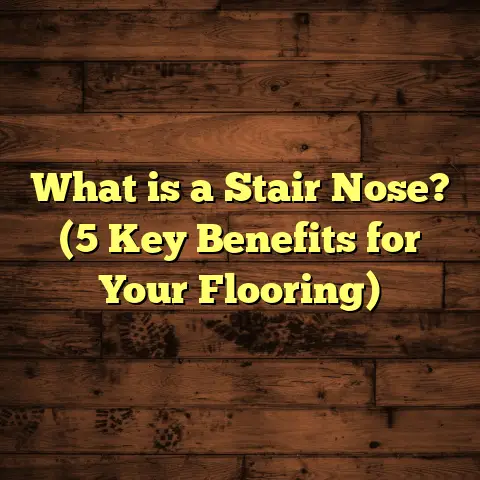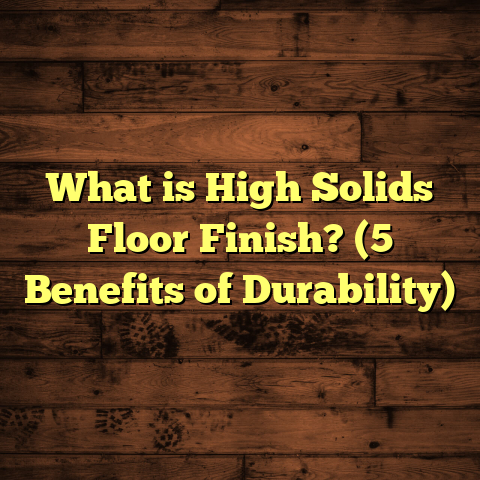What is Hardwood Parquet Flooring? (5 Key Benefits Explained)
Living here in the Northeast, where the weather swings from snowy winters to humid summers, I’ve really come to appreciate the importance of choosing the right flooring. I’ve walked into homes with floors that show every scratch and mark from daily life, and others where the floors seem to age gracefully, almost like a fine wine. Over the years working as a flooring contractor and enthusiast, hardwood parquet has stood out to me both for its beauty and practicality. It’s a flooring option that carries history yet fits modern homes perfectly.
If you’re curious about parquet flooring and wondering if it’s right for your home, I want to share everything I know—from technical details and benefits to my personal experiences and insights from real-world projects. Let’s unravel what hardwood parquet flooring is all about, why it’s worth considering, and how it performs in different situations.
What Is Hardwood Parquet Flooring?
Hardwood parquet flooring is a style of wood flooring made by assembling small pieces of hardwood into repeating geometric patterns. Unlike traditional hardwood floors where long planks are installed parallel to one another, parquet flooring is all about design—the blocks are arranged to create visual interest with patterns like herringbone, chevron, basketweave, or even more intricate mosaics.
The word “parquet” comes from the French parchet, meaning “small compartment.” This style actually began in 17th-century France as an alternative to marble floors in grand homes and palaces. It was favored for its elegance but also for being less slippery and easier to maintain than marble.
Today, parquet flooring is crafted from various hardwood species including oak, maple, walnut, cherry, and even exotic woods like teak or mahogany. These small wood pieces are glued or nailed together onto a subfloor and then sanded down to a smooth finish. The results can be stunning—flooring that acts as both a foundation and an art piece.
How Does Parquet Differ From Other Hardwood Floors?
It’s easy to get parquet confused with engineered hardwood or laminate floors because all involve wood or wood-like materials. But here’s the key difference:
- Traditional plank hardwood floors use long boards laid side by side.
- Parquet uses small wood blocks arranged in intricate patterns.
- Engineered hardwood has a plywood base with a thin hardwood veneer on top.
- Laminate is synthetic with a photographic wood image under a protective layer.
Parquet floors are typically solid wood blocks or layers of solid wood glued together. This makes them more durable than laminate and often thicker than engineered options.
1. Timeless Beauty and Unique Style
One of the biggest reasons I recommend hardwood parquet flooring is its timeless beauty. You don’t just get a floor; you get a design element that defines your space. The geometric patterns add depth and texture to any room.
Let me tell you about a project I did last spring — a family wanted their newly renovated dining room to feel warm but sophisticated. We chose a classic herringbone pattern with white oak. The staggered zigzag pattern created visual movement that made the room feel lively yet elegant. It wasn’t just about aesthetics; it became the conversation starter at every dinner party they hosted afterward.
Patterns That Speak
You might wonder: which parquet pattern suits my home? Here are some popular ones I often use:
- Herringbone: Rectangular blocks placed at 45 or 90-degree angles create a “fishbone” look.
- Chevron: Blocks cut at an angle meet in a continuous zigzag.
- Basketweave: Small rectangular blocks alternate horizontally and vertically like woven fabric.
- Versailles: A complex square pattern combining diagonal and straight pieces for a vintage look.
These patterns can complement different styles — from rustic farmhouse to sleek contemporary. And because parquet uses smaller blocks, you can create borders or medallions that highlight room features like fireplaces or staircases.
Data on Style Popularity
From my research and industry reports like those from the National Wood Flooring Association (NWFA), parquet flooring remains a popular choice for renovation projects in older homes—especially those built before 1950. Around 25% of historic home restorations in urban areas use parquet or similar patterned hardwoods to maintain architectural integrity.
Moreover, interior designers often rate parquet as one of the top five flooring types for adding sophistication without overwhelming the space.
2. Durability That Lasts for Generations
Durability is crucial if you want your floors to age well and keep looking good through daily wear. I’ve seen too many softwood floors dented or scratched by pets, kids’ toys, or moving furniture. Parquet flooring offers a durable solution due to several factors.
Why Is Parquet So Durable?
First, hardwood itself is strong. Species like oak or maple have high Janka hardness ratings (oak scores around 1360), which means they resist dents and scratches well compared to softer woods like pine.
Second, because parquet is made of small blocks tightly fitted together, impact forces disperse across multiple pieces rather than one long plank taking all the pressure. This reduces warping or cupping caused by humidity changes or heavy foot traffic.
Lastly, most parquet floors receive protective finishes such as polyurethane or aluminum oxide coatings that form hard surfaces resistant to moisture, stains, and abrasion.
My Experience With Heavy-Traffic Areas
In commercial settings like boutique stores or restaurants I’ve worked on, parquet floors withstand daily foot traffic better than expected. One café we renovated had an original parquet floor from the 1940s; after refinishing it twice over three decades, it still looked great — no signs of structural damage or excessive wear.
Scientific Data on Longevity
Studies conducted by the Wood Flooring Manufacturers Association (WFMA) indicate that well-maintained hardwood floors last between 30 to 100 years depending on usage and species. Parquet flooring generally falls in the middle to upper end of this range because of its construction method and maintenance ease.
3. Easy Maintenance and Repair
Let’s talk about maintenance because that’s usually a big question mark for anyone considering wood floors.
Daily Care
Parquet floors are fairly low-maintenance compared to carpet or tile grout lines that trap dirt. Sweeping or vacuuming regularly removes dust and grit that can scratch surfaces. For deeper cleaning, a damp mop with a cleaner specifically designed for hardwood keeps it looking fresh.
Avoid excessive water — wood hates standing moisture — so wipe spills immediately.
Repairing Parquet Floors
One advantage I love about parquet is how easy it can be to repair compared to traditional planks. If just one section gets scratched or damaged, you don’t have to replace an entire floorboard; you can remove that block and install a new one.
In one project, a client’s dog scratched an area near the entrance badly enough that we replaced about 10 blocks in the herringbone pattern seamlessly. The floor looked as good as new without major disruption.
Refinishing Intervals
Depending on wear, parquet floors usually need refinishing every 10-15 years. This process involves sanding off the old finish and applying new coats of sealant. The sanding reveals fresh wood beneath, making floors look brand new again without replacing materials.
4. Health Benefits Through Improved Indoor Air Quality
You might not instantly connect flooring choice with your health, but it matters—especially if allergies or asthma affect your household.
How Hardwood Helps Allergy Sufferers
Carpet traps dust mites, pet dander, pollen, and other allergens deep within fibers where vacuuming struggles to reach them fully. Hardwood floors—including parquet—don’t have fibers to trap allergens; dust sits on the surface where it can be cleaned easily.
This helps reduce indoor airborne allergens significantly.
Regional Considerations for Air Quality
Here in the Northeast, we spend months indoors during cold weather with windows sealed tight. This can cause stale air buildup with allergens circulating freely inside homes. Choosing hard surfaces like parquet flooring improves ventilation efficacy when combined with air purifiers or HVAC filters.
The Environmental Protection Agency (EPA) confirms homes with hardwood floors generally report fewer allergy symptoms compared to carpeted homes.
5. Increases Home Value and Appeal
When you invest in your home’s flooring, you want it to add resale value too. Hardwood parquet flooring delivers both curb appeal and lasting value.
Real Estate Market Insights
According to Remodeling Magazine’s Cost vs. Value Report:
- Hardwood floors provide an average return on investment (ROI) of about 70-80%.
- Parquet flooring often commands an even higher premium due to its unique design.
- Homes with original hardwood or parquet floors tend to sell faster because buyers associate them with quality and care.
Personal Stories From Sellers
I once helped a client stage their home for sale after installing custom walnut parquet in their foyer and living room. The realtor told me the floor was one of the top features that attracted buyers during open houses.
The house sold within two weeks at asking price — an uncommon outcome in that market at the time.
My Personal Take: Why Parquet Stands Out
Having installed hundreds of floors over my career, I’m always rooting for options that combine beauty with durability and practical benefits. Hardwood parquet keeps winning because:
- It’s versatile enough for different interior styles.
- It lasts long even under stress.
- It requires manageable upkeep.
- It supports healthier indoor air.
- It adds solid financial value to homes.
I remember one weekend project where we installed a cherry wood parquet floor in a cozy cottage upstate during early fall. As leaves changed outside, inside felt warm and inviting due largely to that patterned wood floor reflecting soft light from the windows.
Additional Considerations Before Choosing Parquet Flooring
If you’re thinking about making parquet your next flooring choice, here are some practical tips based on my experience:
Climate Impact
Wood expands and contracts with humidity changes—a big factor in places with extreme seasonal shifts like where I live. Proper acclimation before installation (letting wood rest in your home environment) helps prevent gaps or buckling later.
Subfloor Preparation
A flat, clean subfloor is critical for parquet installation because uneven surfaces can cause loose blocks or squeaks over time.
Installation Options
- Glue-down installation is common for solid parquet blocks.
- Nail-down works well on wooden subfloors but less so on concrete.
- Some manufacturers offer preassembled parquet tiles for easier DIY installation.
Cost Factors
Parquet flooring tends to be more expensive than standard plank hardwood due to labor-intensive installation and design complexity. Expect material costs around $5-$15 per square foot plus installation fees ranging from $6-$12 per square foot depending on pattern difficulty and region.
Using online tools like FloorTally can help you estimate your specific project costs based on local labor rates and material choices.
Case Study: Renovating a Historic Home With Parquet Floors
In 2023, I worked on restoring a Victorian-era home built in 1890 in Boston. Most original floors were damaged beyond repair except for small sections of elaborate parquet near doorways and hallways.
Our team decided to replicate those patterns using reclaimed oak blocks matched carefully for color and grain with new pieces where needed. After meticulous sanding and finishing with durable oil-based polyurethane, the restored floors became focal points throughout the home.
The homeowners loved how parquet connected their modern renovations back to history while providing practical durability for everyday life with two kids and pets.
Frequently Asked Questions About Hardwood Parquet Flooring
Q: Can parquet be installed over radiant heating?
A: Yes! Parquet works well over radiant heat systems but requires proper acclimation and installation techniques to accommodate expansion without damage.
Q: Is parquet harder to clean than regular hardwood?
A: Not really—cleaning requirements are similar since both have smooth finishes. Just avoid excess water on any hardwood surface.
Q: Can I install parquet myself?
A: If you have DIY skills, some preassembled tile options simplify installation. However, custom patterns usually require professional installers due to precision needed.
Q: How does parquet hold up against pets?
A: Hardwood can show scratches from pet nails but choosing harder species like oak or maple combined with protective finishes helps minimize damage.
Final Thoughts
Hardwood parquet flooring blends natural beauty with craftsmanship that suits both historic charm and modern aesthetics. Over decades of personal experience installing these floors across regions with changing climates like mine, I’ve seen firsthand their ability to enhance spaces while standing up to life’s challenges.
If you want flooring that offers character, durability, easier maintenance, better air quality, and lasting value — parquet deserves serious consideration. What about you? Have you ever lived with parquet floors? Or are you thinking about installing them? Feel free to reach out if you want advice tailored to your project!





